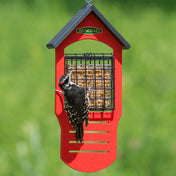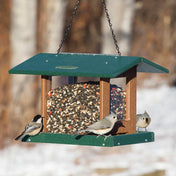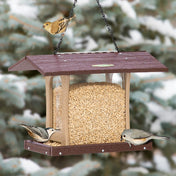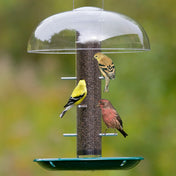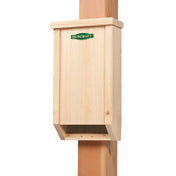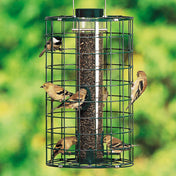
Chickadees are cute, agile and friendly; however, the next time you hear a familiar “chick a dee dee dee,” listen closely because a chickadee’s call can tell you a lot. Biologists have discovered the more “dees” there are in a Black-capped Chickadee’s warning call, the more dangerous was a would-be predator. Chickadees also have a quiet “seet” call, which is believed to warn others of flying raptors. And families of birds will call back and forth, informing each other of their location. In fact, biologists have recognized more than 30 variations in chickadee songs and calls.
In addition to their variety of calls, chickadees are charming little birds that can entertain you with their antics and tameness. When you’re visiting or filling your feeders, this brave little songbird waits patiently close by, offering you some very up-close views!
You can feed chickadees from your hand with a little sunflower seed. And since chickadees are so naturally curious and tame, it’s easy to feed them right from your hand. Load up with sunflower seeds or sunflower hearts, or bits of chopped up walnuts. Stand close to your feeder or a tree with your palm flat and hand outstretched at arm’s length. Stay perfectly still! With patience, you will be rewarded with a brief visit that feels like a puff of air on your fingertips!
There are seven species of chickadees found in North America. The Black-capped Chickadee is found in the northern half of the U.S., the Carolina Chickadee is found in the southeast, the Mountain Chickadee found from the Rockies and west to California. Other chickadees are the Chestnut-backed, found in the northwest, the Boreal, found in Canada and Maine, and the lesser known Gray-headed of Alaska and the Mexican Chickadee, found in lower Arizona and New Mexico. No matter where you live in the country, it’s likely that you have chickadees in your area.
Although chickadees seem to be always at our feeders, the main staple of their diets is insects. Chickadees also enjoy insect eggs, spiders and spider eggs, berries and pine cone seeds. They cache food under tree bark for winter when food is scarce, and just like squirrels, they do remember where they hid their stash!
Tips for Attracting Chickadees
 It’s easy to attract chickadees to your yard. They are very adaptable and can feed from platform feeders, tube feeders and any feeder where their natural clinging abilities come into play, such as the Cling-A-Wing globe feeder. Offer chickadees black oil sunflower seeds, whole sunflower hearts or Duncraft’s nutty Chickadee Blend (shown here).
It’s easy to attract chickadees to your yard. They are very adaptable and can feed from platform feeders, tube feeders and any feeder where their natural clinging abilities come into play, such as the Cling-A-Wing globe feeder. Offer chickadees black oil sunflower seeds, whole sunflower hearts or Duncraft’s nutty Chickadee Blend (shown here).What else can you do to attract them? You can help chickadees by offering nest boxes. Chickadees are cavity nesters, using abandoned woodpecker holes to raise their young, and they readily accept birdhouses as nesting spots. Chickadees prefer houses with floors that are about 4 x 4 inches square, 8 to 10 inches tall and placed 6 to 15 feet high, either on a post or on a tree. But any house with measurements close to these will be fine for the amiable chickadee. And consider offering roosting boxes during winter, since these have entry holes on the bottom to minimize drafts with perches inside. Often, many birds will huddle together inside the boxes on cold, windy nights, conserving warmth and energy.
And last, but not least…remember the water! Ice-free water is important for all birds in winter when water sources are frozen. Try a heater in your bird bath or a heated bath. With food, shelter and water, your chickadees can be happy and healthy all year long and provide you with endless enjoyment. Shop duncraft.com today for bird seed, suet, heated birdbaths and more. Happy Birding!


